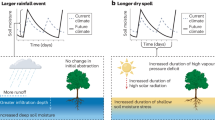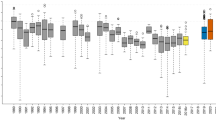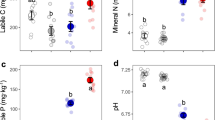Abstract
Understanding the relative abundance of species in plant communities is an unsolved problem 1,2,3,4,5,6,7,8,9,10. Mechanisms such as competition, resource partitioning5, dispersal ability10 and predation tolerance6,7,8,9 do not adequately explain relative abundance under field conditions11,12. Recent work suggests that interactions between plants and soil microbes is important13,14,15,16,17,18,19,20,21. Here I show that such interaction explains a significant proportion of the variance in the relative abundance of species in plant communities. Rare plants exhibited a relative decrease in growth on ‘home’ soil in which pathogens had had a chance to accumulate, whereas invasive plants benefited from interactions with mycorrhizal fungi. Some plant species accumulate pathogens quickly and maintain low densities as a result of the accumulation of species-specific pathogens, whereas others accumulate species-specific pathogens more slowly and do not experience negative feedback until plant densities reach high levels13,15,21. These results indicate that plants have different abilities to influence their abundance by changing the structure of their soil communities, and that this is an important regulator of plant community structure.
This is a preview of subscription content, access via your institution
Access options
Subscribe to this journal
Receive 51 print issues and online access
$199.00 per year
only $3.90 per issue
Buy this article
- Purchase on Springer Link
- Instant access to full article PDF
Prices may be subject to local taxes which are calculated during checkout



Similar content being viewed by others
References
Pysek, P., Prach, K., Rejmanek, M. & Wade, M. Plant Invasions: General Aspects and Special Problems (SPB Academic, Amsterdam, 1995).
Huston, M. A. Biological Diversity. The Coexistence of Species on Changing Landscapes (Cambridge Univ. Press, Cambridge, 1994).
Ricklefs, R. E. & Schluter, D. Species Diversity in Ecological Communities (Univ. Chicago Press, Chicago, 1993).
Gaston, K. J. Rarity (Chapman & Hall, London, 1994).
Grace, J. B. & Tilman, D. Perspectives on Plant Competition (Academic, San Diego, 1990).
Belsky, A. J. Effects of grazing, competition, disturbance and fire on species composition and diversity in grassland communities. J. Veget. Sci. 3, 187–200 (1992).
Milton, W. The effect of manuring, grazing and cutting on the yield, botanical and chemical composition of natural hill pastures. J. Ecol. 28, 326–356 (1940).
Crawley, M. J. in Insect–Plant Interactions (ed. Bernays, E. A.) Vol. 1, 45–71 (CRC Press, Boca Raton, 1989).
Reader, R. J. Relationship between species relative abundance and plant traits for an infertile habitat. Plant Ecol. 134, 43–51 (1998).
Rabinowitz, D., Rapp, J. K., Cairns, S. & Mayer, M. The persistence of rare prairie grasses in Missouri: environmental variation buffered by reproductive output of sparse species. Am. Nat. 134, 525–544 (1989).
Tokeshi, M. Species Coexistence: Ecological and Evolutionary Perspectives (Blackwell Science, Oxford, 1999).
Tilman, D. in Biodiversity and Ecosystem Function (eds Schulze, E.-D. & Mooney, H. A.) 327–344 (Springer, Berlin, 1994).
Van der Putten, W. H., Van Dijk, C. & Peters, B. A. M. Plant-specific soil-borne diseases contribute to succession in foredune vegetation. Nature 362, 53–56 (1993).
Grime, J. P., Mackey, J. M. L., Hillier, S. H. & Read, D. J. Floristic diversity in a model system using experimental microcosms. Nature 328, 420–422 (1987).
Bever, J. D. Feedback between plants and their soil communities in an old field community. Ecology 75, 1965–1977 (1994).
Bever, J. D., Westover, K. M. & Antonovics, J. Incorporating the soil community into plant population dynamics: the utility of the feedback approach. J. Ecol. 85, 561–573 (1997).
Van der Heijden, M. G. A. et al. Mycorrhizal fungal diversity determines plant biodiversity, ecosystem variability and productivity. Nature 396, 69–72 (1998).
Packer, A. & Clay, K. Soil pathogens and spatial patterns of seedling mortality in a temperate tree. Nature 404, 278–281 (2000).
Mills, K. E. & Bever, J. D. Maintenance of diversity within plant communities: soil pathogens as agents of negative feedback. Ecology 79, 1595–1601 (1998).
Callaway, R. M. & Ascheloug, E. T. Invasive plants versus their new and old neighbors: a mechanism for exotic invasion. Science 290, 521–523 (2000).
Olff, H., Hoorens, B., de Goede, R. G. M., van der Putten, W. H. & Gleichman, J. M. Small-scale shifting mosaics of two dominant grassland species: the possible role of soil-borne pathogens. Oecologia 125, 45–54 (2000).
Burdon, J. J. Diseases and Plant Population Biology (Cambridge Studies in Ecology, Cambridge Univ. Press, Cambridge, 1987).
van der Putten, W. H. Pathogen-driven forest diversity. Nature 404, 232–233 (2000).
Blomqvist, M. M., Olff, H., Blaauw, M. B., Bongers, T. & van der Putten, W. H. Interactions between above- and belowground biota: importance for small-scale vegetation mosaics in a grassland ecosystem. Oikos 90, 582–598 (2000).
Klironomos, J. N., Moutoglis, P., Kendrick, B. & Widden, P. A comparison of spatial heterogeneity of vesicular-arbuscular mycorrhizal fungi in two maple-forest soils. Can. J. Botany 71, 1472–1480 (1993).
Bragulat, M. R., Abarca, M. L., Bruguera, M. T. & Cabanes, F. J. Dyes as fungal inhibitors: effect on colony diameter. Appl. Environ. Microbiol. 57, 2777–2780 (1991).
Domsch, K. H., Gams, W. & Anderson, T.-H. Compendium of Soil Fungi Vol. 1 (Academic, London, 1980).
Acknowledgements
I thank J. Bever, M. Hart, B. Husband and R. Reader for comments on the manuscript. I also thank A. Jones, G. LaPierre, G. Lewis, D. MacIntosh, J. Martin, J. Mosquin, P. Moutoglis and A. Shaw for laboratory and field assistance. This work was supported by a grant from the Natural Sciences and Engineering Research Council of Canada.
Author information
Authors and Affiliations
Corresponding author
Ethics declarations
Competing interests
The author declares that he has no competing financial interests
Rights and permissions
About this article
Cite this article
Klironomos, J. Feedback with soil biota contributes to plant rarity and invasiveness in communities. Nature 417, 67–70 (2002). https://doi.org/10.1038/417067a
Received:
Accepted:
Issue Date:
DOI: https://doi.org/10.1038/417067a
This article is cited by
-
Contrasting plant growth performance of invasive polyploid and native diploid Prosopis is mediated by the soil bacterial community
Ecological Processes (2023)
-
Modelling how negative plant–soil feedbacks across life stages affect the spatial patterning of trees
Scientific Reports (2023)
-
Significant changes in soil microbial community structure and metabolic function after Mikania micrantha invasion
Scientific Reports (2023)
-
Effects of moisture and density-dependent interactions on tropical tree diversity
Nature (2023)
-
Plant-soil feedback in the ‘real world’: how does fire fit into all of this?
Plant and Soil (2023)
Comments
By submitting a comment you agree to abide by our Terms and Community Guidelines. If you find something abusive or that does not comply with our terms or guidelines please flag it as inappropriate.



